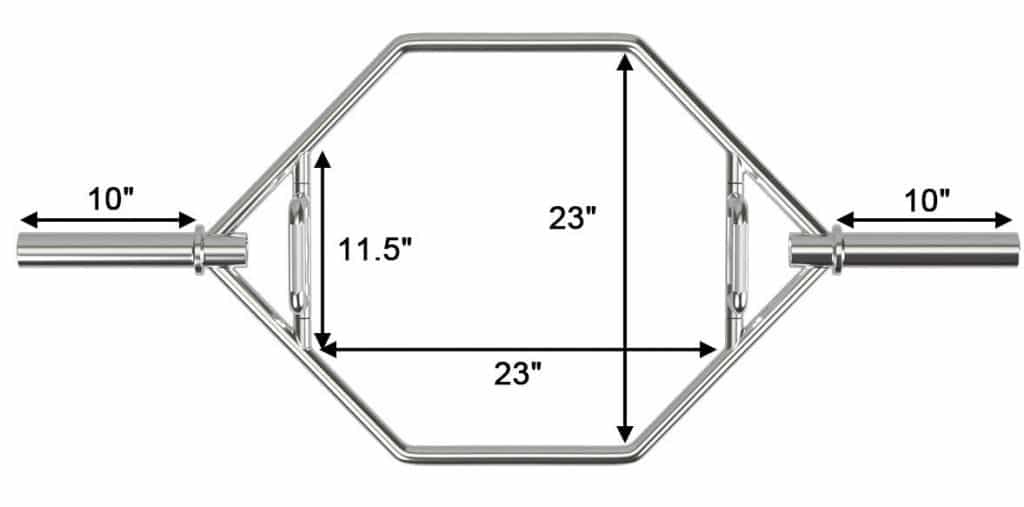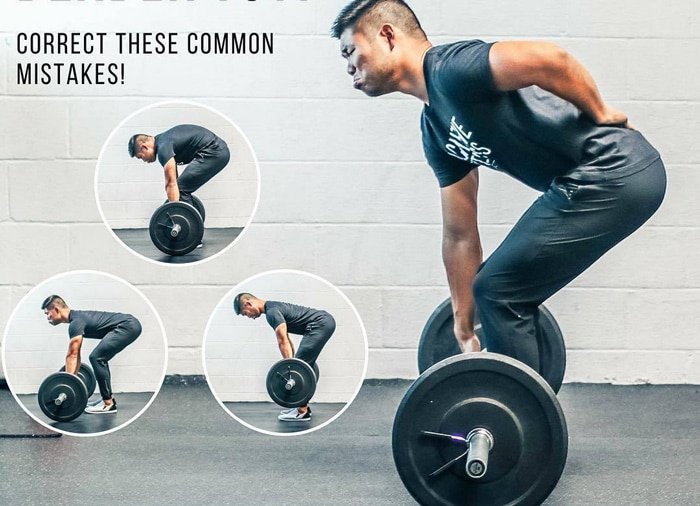If you had to choose one exercise to build muscle, strength, function, and conditioning… the deadlift should definitely be in a running. The fact that this movement involves the lower and upper body to a large degree certainly makes it one of the best bang for the buck options.
However, the conventional straight bar version isn’t exactly ideal for everyone and we’ll explain why shortly. But we wanted to offer a few trap bar deadlift workouts that’ll offer you many of the same benefits.
So, we’ve explained a little about the trap bar and its advantages/benefits, in addition to providing exercise instructions, important tips, and then 4 very effective trap bar deadlift workouts.
What’s A Trap Bar?
The trap bar, also known as the hex bar, is a hexagonal-shaped implement that allows you to stand in the center of it. It has two raised, square handles that allow for easy gripping in addition to another pair level with the bar and you can actually flip the bar to use either side.

Then you have the two stubs located on the outermost part of the flat handles for loading the weight plates.
Now, originally, the trap bar was designed for easy trapezius muscle training (shrugs). However, it’s effectively used for a variety of movements, one of which is obviously the deadlift.
Level Up Your Fitness: Join our 💪 strong community in Fitness Volt Newsletter. Get daily inspiration, expert-backed workouts, nutrition tips, the latest in strength sports, and the support you need to reach your goals. Subscribe for free!
How To Do The Trap Bar Deadlift
Here’s a step-by-step for how to safely and effectively perform the trap bar deadlift…
- Position your feet about hip-width or however you feel most comfortable, and either point your toes forward or slightly outward.
- Squat down and decide where you want your hips to be positioned. You can dip your hips lower due to having a freer range of movement, or you can keep your hips high to mimic the conventional deadlift. Both have benefits.
- Grip the handles in the center.
- Keep your back straight, chest up, core tight, and flex your lats (back muscles).
- Push through your heels and when the bar reaches mid-thigh, move your hips forward to lockout at the top.
- Lower the bar back down the same way.
Important form tips
- Use lighter weight if just starting out and really practice maintaining good form before progressing with heavier loads. The trap bar deadlift may require more stability due to the shape and design of the bar. Therefore, you don’t want to be wobbling all over the place.
- It’s a good idea to use both a low and high hip position as each has its advantages. Low hips activate more quads and can really strengthen the bottom portion of the deadlift. High hips will allow you to better utilize the hip hinge which is recommended for improving your deadlift in general.
- It’s recommended to grip the handles in the center to maintain perfect balance.
- Using the level handles will definitely increase the difficulty of the trap bar deadlift. It’s a good idea to use both sides of the implement depending on your goals and workouts.
- Ultimately, you should find a stance/foot-position that’s most comfortable for you.
4 Effective Trap Bar Deadlift Workouts
Alright, let’s get into the trap bar deadlift workouts that are going to put on size and increase your strength without a doubt.
Note: You can either use the raised D-shaped handles or flip the implement over and use the low handles.
20-Rep EMOM (every minute on the minute)
So not only is this workout very effective for total body development, but you’ll have no choice but to mentally push through the pain as well. It’s not going to be easy by any means but you’ll feel extremely satisfied afterward.
Now, you’ll only do one set of 20 reps, however, this will be done 5 reps at a time EMOM style. So, you’ll do 5 reps on the minute and after your last rep, you’ll rest for the remainder of the minute and continue this until you’ve completed 20 reps. It should, ideally, take you four minutes to complete this workout.
We recommend using a challenging weight

3×5 Cluster Set
Cluster sets allow you to train heavier while completing more repetitions in a single set. And you can achieve this by performing one rep at a time while taking short rest breaks in between each rep. So the goal with this specific workout is to use your 4-rep max (amount of weight you can lift for four reps), but you’ll aim for 5-6 reps.
So, you’ll perform one repetition, rest 20 seconds, perform another rep, rest 20 seconds, and continue this until you’ve completed 5-6 repetitions. Then, you can rest 2-3 minutes before you complete the next set.
Ladder Set
To do a ladder set, start with 90% of your one-rep max and perform 3 reps. Tip: Use some smaller plates to be able to strip and add a few pounds at a time.
Then, remove one plate on each side and perform 5 reps. remove the next two plates and complete 7-8 reps. Finally, remove the next two plates and complete 9-10 reps.
Now add a plate back on each side and complete 7-8 reps. Add another two plates and do 5 reps, then lastly, add the two remaining plates and do 3 reps.
You’ll do only one set.
Trap Bar Deadlift/Straight-Arm Pushdown Superset
Because the trap bar deadlift requires plenty of scapular strength and stability and lat activation, it makes sense to maximize this aspect of the lift. Therefore, we can do a superset that involves the trap bar deadlift and the straight-arm pushdown.
Level Up Your Fitness: Join our 💪 strong community in Fitness Volt Newsletter. Get daily inspiration, expert-backed workouts, nutrition tips, the latest in strength sports, and the support you need to reach your goals. Subscribe for free!
This exercise is not only beneficial for improving the development and function of the upper posterior muscles but it’s a good habit to subconsciously remind yourself to maintain good lifting form.
So, for this workout, you’ll do 10 reps of straight-bar pushdowns immediately followed by 10 reps of trap bar deadlifts for three rounds. By doing the pushdowns first, you’ll have already gotten in the habit of maintaining proper positioning.
To do straight-arm pushdowns:
- Attach a straight bar or rope to the top of a cable machine.
- Standing a few feet away from the machine, grip the handles with hands about shoulder-width apart and arms extended.
- Lean forward slightly keeping your back straight, shoulders back and chest up.
- Tense your lats then pull your arms down toward your thighs.
- Slowly allow your arms to move back up just to shoulder height and repeat.
Do 3 sets total of this superset.
Advantages/Benefits of trap bar deadlifts
The trap bar deadlift can be advantageous when compared to the conventional deadlift in a few ways. However, we’re not at all saying it’s superior because each one does have its advantages.
Less spine and lower back stress
What does the trap bar offer that the conventional straight bar doesn’t? Well, because you can stand in the middle of the hexagonal-shaped bar stock, the weight is more closely in line with your center of mass and you can maintain a slightly more upright position.
Your knees aren’t limited in their movement forward like with the straight bar and as a result, the quads will get a little more activation compared to the conventional deadlift. The conventional deadlift is a more hip-dominant exercise that requires a focus on hip hinging that causes the torso to be positioned forward rather than more upright as with the trap bar deadlift.
Although, you can still use the same technique for the trap bar deadlift as you would the conventional if you so choose (e.g. knees back, and hips high).
Also, with the conventional deadlift, because you’re bending forward to pull the weight, it’s possible to place additional stress on the lumbar spine in addition to the shoulders and biceps too.
The trap bar can offer a little more safety on the spine and lower back for many people and is a great way to safely and effectively teach beginners, taller lifters, and older individuals how to hinge at the hips while loading a little heavier too. Although, it’s not a replacement for the straight bar if your goal is to be strong and proficient with the conventional deadlift.
So, you’ll have to weigh out your goals and decide the most optimal way to train for you.

A shorter range of motion
The raised bars shorten the range of motion which is not a bad thing at all. In fact, it’s much more ideal for those with less than optimal mobility in the hips and knees, and you’re still not limited as far as the potential benefits that you can experience with the deadlift.
The shorter range of motion with the trap bar is also great for loading up real heavy to mimic a deadlift type movement.
Optimal functional carryover
How do we carry bags, dumbbells, and other similar objects? Using the same body position that we do when performing the trap bar deadlift. Not to mention, the farmer’s walk (you can do this with a trap bar), which is one of the most functional strength and endurance exercises, is also performed this way.
The trap bar deadlift is a great option for improving our strength and overall function in this same exact body position. It’s more ideal for moving around with heavy weights. Not to mention, using a neutral hand position is also ideal for building functional grip strength.
Stronger conventional deadlift
Trap bar deadlifts can actually strengthen your conventional deadlift. That’s because, if you keep your hips low, you’re forced to activate more quads out of the bottom, strengthening these muscles, which then carries over into your conventional deadlift.
Not to mention, many people find that the trap bar deadlift builds their quads better than squats especially if you can use a lot of weight.
Wrapping Up
The trap bar deadlift can definitely make a big difference in your training and overall progress. It’s also a great alternative to the conventional deadlift depending on your goals and capabilities. Not to mention, these four trap bar deadlift workouts are incredibly effective and we’re sure you’ll make some awesome gains if you incorporate them every now and then.
Just make sure to use proper form and learn how to best utilize the trap bar to your advantage.








